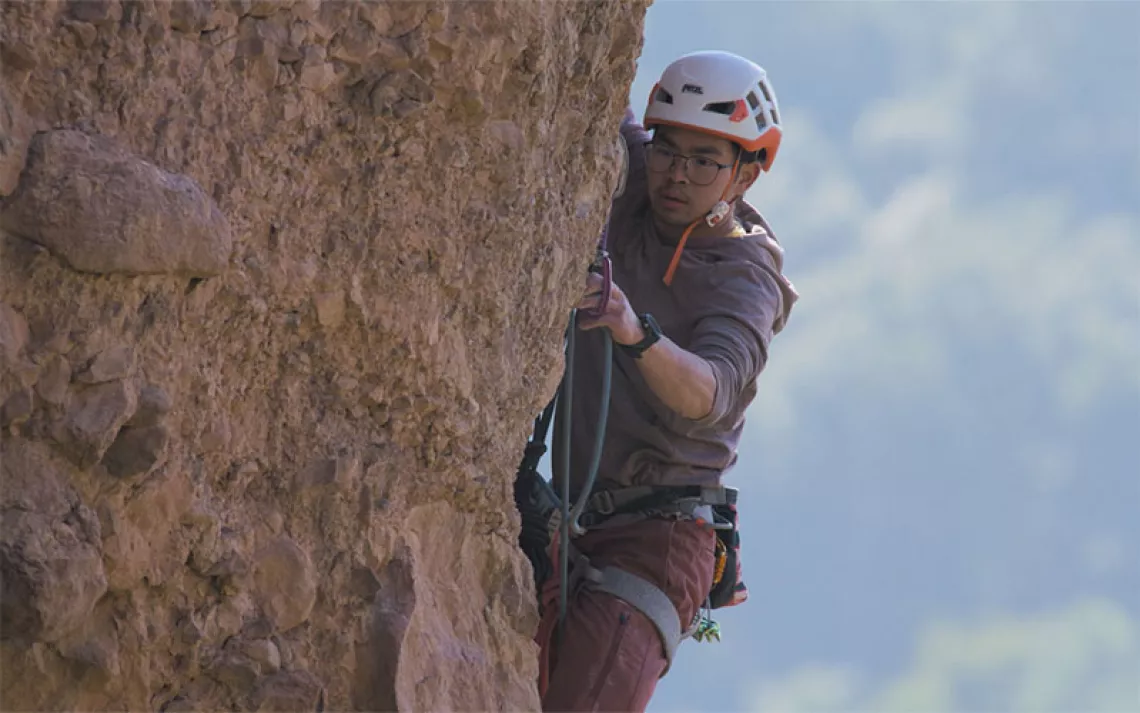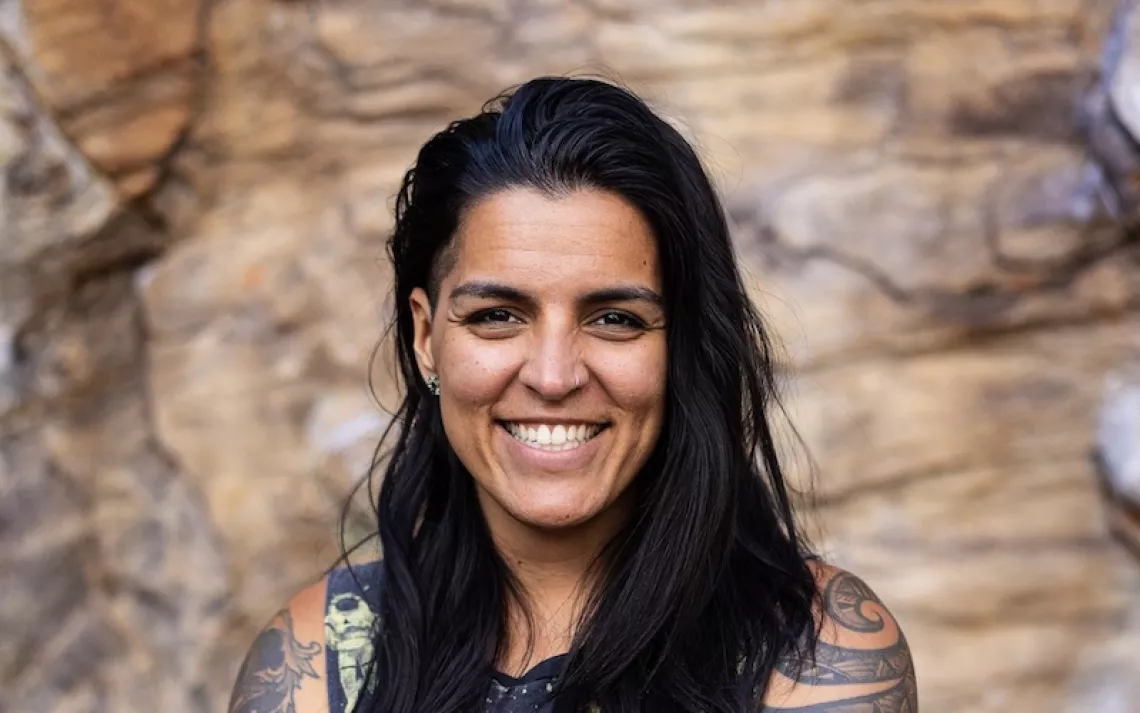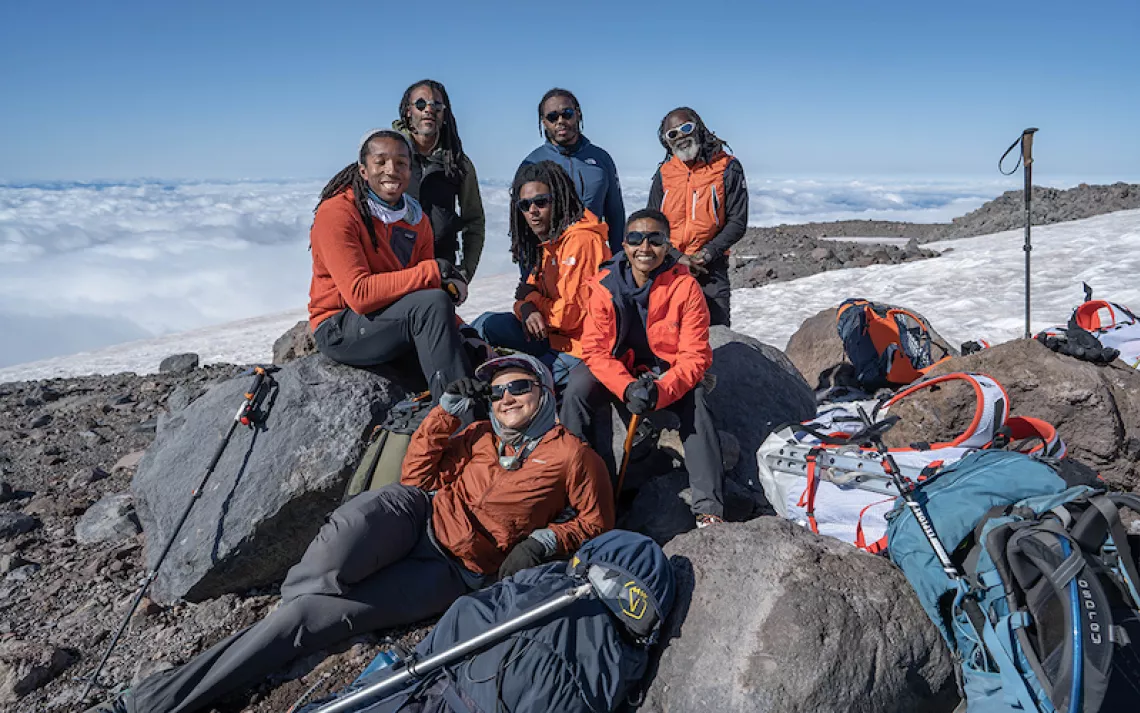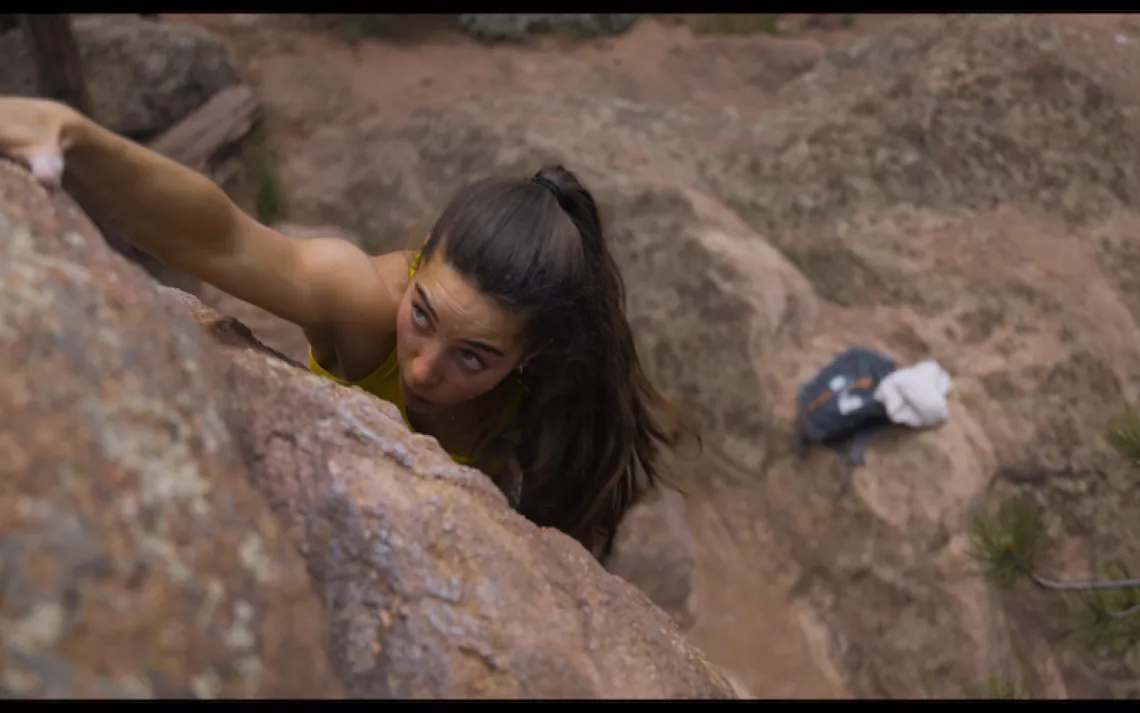I Was Here
A High Sierra search for climbing registers, the voices of climbers past

Mt. Brewer climbing register | Photo by Claude Fiddler
WITH THE SUN FALLING fast behind me, I look up at Black Kaweah and ponder my next move. I'd taken on this remote and treacherous peak as part of my search for the historic summit registers climbers have left scattered throughout the Sierra Nevada, informal archives in the great conversation between climbers living, dead, and yet to be born. Only a few hundred people have visited this 13,765-foot peak since the first alpinist clambered to the top almost 90 years ago. Among them was Walter Starr Jr., who summited shortly after the first ascent. Arriving without pencil or pen, he improvised by signing his name in his own blood. That signature, still in an aluminum box on Black Kaweah's peak in Sequoia National Park, is one of the Sierra's treasures.
But my hopes of topping out sink with the sun, and instead of following in Starr's footsteps, I begin a badly planned retreat in the rapidly gathering darkness.
SIERRA PEAKBAGGING, as recorded in summit registers, began in 1864. On July 2, as Confederate forces advanced toward Washington, D.C., William Brewer, the Yale University–educated field leader of the California Geological Survey, and Charles Hoffman, the team's German-born topographer, scaled a 13,570-foot peak 11 miles northeast of Kaweah in what is today Kings Canyon National Park. Two days later, under cloudy skies and in freezing temperatures, Brewer and surveyor James Gardiner returned to the summit of what has since come to be known as Mt. Brewer.
"We planted the American flag on the top, and left a paper in a bottle with our names, the height, etc.," Brewer later wrote in his journal. "It is not at all probable that any man was ever on the top before, or that anyone will be again--for a long time at least."
Exactly 143 years after the first ascent, and several weeks before my Kaweah climb, I'd heaved myself onto that same granite ridge on a blazing afternoon under an impossibly blue sky. After catching my breath, I anxiously looked for the summit register, finding it inside a custom-made cast aluminum box. Thousands of people had visited the top before me, but this register only recorded the past four years. It included political rants, testimony from a very recently reformed smoker, and a note from a party of three who claimed to be Brewer's descendants. Over the years, scrawled in old registers now stored back in civilization, some climbers' entries aspired to poetry; others oozed with vulgarity. Their observations ran from effusive to terse ("Decided to celebrate my 38th birthday here--should have stuck to handball") to stark confessions of stark nudity, as one Dagmar Montanaro reported her condition. A subsequent visitor verified her clothes-free status, adding parenthetically "crazy women."
The tradition Brewer started was enthusiastically taken up by a young Sierra Club. In the summer of 1894, by directors' decree, the Club established summit registers and boxes on Mt. Dana, Mt. Lyell, and four other prominent points. Writing in the Sierra Club Bulletin (the precursor to Sierra), John Muir himself asked Club members to "show your appreciation of the Sierra Club and of its purpose by using care in replacing this register in the box, and by restoring the box to the spot whence taken."
Since then the pages have come to serve as bulletin boards, public forums, and personal ads. Climbing Middle Palisade in 1930, Sierra legend Starr penned a simple route description. Things got weirder as the years passed. "Saw Yeti, abominable snowman on way up" reported a climber on Mt. Brewer in 1969. "About to smoke Thailand weed--expect to float down." Then there is "Titus Donner" on summiting Matthes Crest in 1995:
"Titus sighed, took a deep breath and puked. Our man of the peaks, having just eaten roasted thigh, couldn't help but wonder if life as a flatlander may be a better choice. Ah, but all fantasies come crashing down around his untied Sportivas, for his pact with the devil committed him to the world of peak baggin."
I WAS FORTUNATE TO BE ABLE to commune with my fellow summiteers atop Mt. Brewer, because in recent years more and more historic registers have vanished. There are as many theories about what's happening to them as there are about what to do with those that remain. Some think fervent wilderness protectors have tossed them off the mountaintops. Others imagine unscrupulous climbers smuggling them into private collections. Still more believe they may have fallen prey to the elements, human clumsiness, or some combination thereof. The Sierra's summits still harbor a scattering of original or decades-old books, squirreled away like pirate treasure in tobacco tins and film canisters across the Range of Light. But with each tattered slip of yellowed register paper that goes missing, a scrap of history fades like failing alpenglow.
"Certainly there are people who consider summit registers trash," says Tina Bowman, former mountain records chair of the Sierra Club Angeles Chapter's Sierra Peaks Section. "That might explain the disappearance of some registers along with the containers. Some people might want the books as souvenirs. I would think these would be people who haven't climbed a lot of peaks, or else they'd appreciate the value of seeing an older register on the summit and leaving it there for others to enjoy."
The original Brewer register remained on the eponymous peak for 32 years, until climbers took the already historic artifact to the Club's San Francisco headquarters. Ten years later it was destroyed in the 1906 earthquake and fire. The removal and subsequent demise of Brewer's bottle has been a sticking point for generations of mountaineers. Preservation has long been the Club's policy for the registers--when an old one fills up, it comes down, replaced by clean sheets. So even if I'd had time that sunny afternoon on the peak, I couldn't have read the full collection of the Mt. Brewer registers. Along with books from scores of Sierra summits, those records are kept at the University of California at Berkeley's Bancroft Library, where the Club's mountain records have been stored since 1970. (My personal favorite Brewer entry: "Forced to summit by bears," September 2, 1984.)
Each year the Bancroft receives a few more rescued registers, some overflowing with oxygen-deprived ramblings, others in sad shape, like the rusty, battered 77-year-old tome with the signatures of future Club leader David Brower (1933) and famous climber Steve Roper (1959) plucked off Mt. Julius Caesar by a Santa Cruz climber in 2006.
Some climbers, however, believe the books belong on the summits, no matter their condition. "They should stay there forever, so future generations can enjoy them," says guidebook author R. J. Secor, echoing a sentiment voiced nearly 40 years ago in an old Mt. Brewer register: "I wonder if those people 50 years ago in this book ever thought their names would be intact today," a climber wrote in 1970. "Fifty years from now I wonder if my name will be intact."
He might well wonder. While some registers have found their way to archives at the Bancroft or in California national park libraries, others--Mt. Barnard, Black Mountain, and Palisade Crest, to name a few--have vanished from their mountain homes, practically before peakbaggers' eyes. As early as 1934, Brower found many original registers missing and, along with Hervey Voge, removed some himself. Brower and Voge described the various containers they discovered on the more than four dozen summits they bagged during a two-month "knapsacking orgy" that summer: cocoa, sardine, and peanut butter cans; a typewriter ribbon box; and a glass bottle. Over the years registers have also been stored in tubes or cylinders made of brass or iron, cast aluminum boxes, and PVC pipes, then wedged in crevices or tucked under rock cairns.
What comes down also goes up. As I flipped through the Brewer register, books from two nearby peaks sat miles away in a park employee's office, waiting for a ride back up to nearby Milestone and North Guard Mountains. They'd been there since the summer of 2006, when rescuers grabbed them to see if a 52-year-old solo climber missing from a two-week backpacking trip had made it that far. He had not: A rescue team spotted his body in a steep, narrow chute a couple of hundred feet below where I sat on Mt. Brewer, pondering what to write. Finally I scribbled a message to my soon-to-be-born twins, signed my name, and scampered down the mountain.
A FEW WEEKS LATER, my friend Nate Johnson and I ventured to Yosemite National Park to climb the first two peaks to get official Sierra Club registers: Mt. Dana and Mt. Lyell. As we topped 13,057-foot Dana, the cumulus clouds that drifted lazily by massed like battleships over the eastern Sierra. Turning from white to gunmetal gray, the clouds had us surrounded. We found the register, but fellow climber Hal Borzone, for one, couldn't be bothered.
"I never sign the things," said the 62-year-old schoolteacher, his sunscreen-smeared face a ghostly white. "For me it would be kind of arrogant. When people came up here back in the day, and it took two weeks to get to the base, with mules and 58-pound packs with skillets they busted their hump to carry, or they were the third person to climb the peak, then they deserved to sign their names." Were any mountaintops worthy of a signature? "Maybe a peak like Black Kaweah," he offered.
We cracked open the stuffed register, the contents of the ammunition box springing out like a jack-in-the-box. It was hard to argue with Borzone. The box held a few years' worth of notebooks, an open invitation to a sexual rendezvous, a student's life plan (budget included), and platitudes passing for wisdom. Signers included professors, a Pilates instructor, and many budding memoirists. Silicon Valley computer geeks, ever networking, dropped in business cards, as if there were going to be a raffle for a free lunch.
Such behavior isn't new. In the early years, registers functioned as cheap Club promotion, territorial marking, and license for self-indulgence. Fifteen years after the first official Club registers went up, S. L. Foster, chief electrician of San Francisco's United Railroads, wrote to Club secretary William Colby that the summit register on Yosemite's Mt. Hoffman was so full of records that he had difficulty shoving them all back in their place. He suggested replacing the documents, finding a bigger box, or removing Hoffman "from the list of genuine Sierra Club feats."
Mt. Dana could be stricken from that list as well. By today's standards, Dana is a ho-hum dayhike, offering a relatively easy jaunt for the masses, and it was our warm-up for Mt. Lyell. But it was getting cold with the gathering clouds, and we needed to hustle to get back into Lyell Canyon for the next day's climb. There was no time to sign our names. Having left our business cards at home, we stuffed the register's rowdy contents back into the ammo box and, with Borzone leading the way, scrambled down toward our car.
The next morning, Johnson and I followed the John Muir Trail above the treeline and eventually broke off the packed-dirt path to cross granite slabs toward Lyell--at 13,114 feet, Yosemite's highest point. A thousand feet below the summit, we hit snow and then the Sierra's second-largest glacier. We stopped to put on crampons and detach our ice axes. The glacier had sprung a million leaks, and the mountaineering gear, while not necessary, gave us enough purchase to make our traverse less of a slog.
At the col between Lyell and Mt. Maclure, we met a young climber out for a 28-mile dayhike. He'd already tagged Lyell and was catching his breath after spooking himself on its tricky Class 4 rock. He said goodbye and started up Maclure while Johnson and I gingerly picked our way up the snowfield and onto a blocky wall. We ascended ramps below the sharp, toothlike gendarmes that protect the summit ridge. On top, we found an aluminum Sierra Club box cemented to a granite block just below the summit, where it's sat for more than seven decades.
It wasn't initially welcomed. When two Sierra Club climbers affixed the register there in 1935, they replaced a similar box installed by the California Alpine Club. This displeased National Park Service naturalist C. A. "Bert" Harwell, who ordered a ranger to remove the Club container. "Though a number of peaks may have two, three, or four registers placed on them by different clubs," Harwell wrote to Yosemite superintendent Colonel C. G. Thomson, "I hope Yosemite will not have to come to such a condition which looks to me like unfriendly competitions."
Today Yosemite's unwritten rule is to allow the registers to stay. But some climbers suspect that rangers who don't see the historical value of registers are responsible for their disappearance. When Johnson and I opened Lyell's register box, we found a new notebook placed only two weeks before. Climbers had signed in every day since then, and the register was devoid of any harrowing tales. We added our names, snapped a few pictures, and wended our way back down to the glacier.
THREE WEEKS AFTER I REACHED the top of Lyell, my friend Jeff Nachtigal and his wife, Sara, join me for the climb up Black Kaweah. We hike in a few miles and set up camp the night before to cut off some time and distance from the 14-mile approach that scales two significant passes just to get to the base of the route. The next morning we get a late start, leaving camp around 8:30. As we trudge up the sandy switchbacks of Sawtooth Pass, two climbers descend toward us. When they tell us they climbed Black Kaweah and saw the signatures of Starr, Norman Clyde, Jules Eichorn, and others, I practically jump into their arms with excitement.
Jeff is stricken with a cold, however, and as his energy wanes our speed plummets. After crossing Hands and Knees Pass and descending into a gorgeous basin known as Little Five Lakes, we split up, my friends encouraging me to push for the summit. I run down the trail, hoping to reach the base by 4 p.m. Eight hours from camp, I am still a mile from the base of the route and face the reality of at least ten more miles of hiking to go.
At 4:30 I'm still a half hour from the tarn below Black Kaweah's looming southwest face when I meet Joe Stephens, a climber from the San Francisco Bay Area. He first topped Black Kaweah 20 years before and spent the day preparing for another ascent by scaling other peaks in the Kaweah Range. "It's suicide if you try to climb Black now," he says.
I wiggle my toes as I consider his advice. He's right. I glance back at the peak and retrace my steps, stumbling down the steep forested slope I took out of the deep Big Arroyo, then back up to Little Five Lakes.
A gauzy light covers the sky, the sunset reddened by forest fires burning to the south. I face a dilemma: I can either try to return to camp that night or trek to the backcountry ranger's cabin, hoping to sleep there, albeit without a sleeping bag. But my friends and I had agreed that if I didn't return to camp the next day by 11 a.m., the Nachtigals were to seek help, so I push on, passing by three climbers who are already bedded down for the evening. As dark falls, I arrive at the crest of Hands and Knees Pass. By memory, I work my way down the slabs and scree, barely aided by the sliver of blood-orange moonlight. On a ledge, I don my helmet and turn on my headlamp, then drop to another ledge.
Where I find myself stuck.
Then something catches my eye. From Spring Lake, a few hundred feet below, a light flashes once, then again. I turn my headlamp off and on again, signaling back. I take a deep breath, promising myself (and my wife and unborn twins) I'll never get into a situation like this again, and delicately ease myself down the rounded granite wall. I extend far to my left and inch my fingers into a grassy crack. Lowering my left leg, I shift my weight onto my pointed right foot and ease onto another bench. A wave of nausea rises and falls inside me. I'm glad that's over.
It's nearly 9 p.m. by the time I reach level ground. I still have another Class 3 pass and two or three hours of stumbling before I reach camp. As I try to visualize the cross-country route we took this morning, the light flashes again, and a voice booms out from 50 feet away: "Campsite over here!" I wobble into camp and am greeted by a gigantic hand, which I shake vigorously. The next thing I know, I am being showered with offers of food, water, clothes, and even a tent and sleeping bag.
Around seven the next morning, I get my first full view of the man attached to the hand that welcomed me into camp. Standing seven feet two inches, Ralph Drollinger is a former pro basketball player (he also played center on John Wooden's last UCLA team to win a national championship). The day before he led a group of evangelical Christians, including an 11-year-old boy, to the summit of Black Kaweah. I stuff my pride back down my throat and try to hide my jealousy.
An hour or so later we break camp, and although I am not accustomed to morning hiking prayers, I belt out an "Amen!" at the end of theirs--and add a plea that the register still be there next season when I try again.
Did He Do the Right Thing?
I kept my mouth shut about the woodworth register for 15 years. In 1992, acting on a hunch by my friend Robin Ingraham, my wife, Nancy, and I had climbed Mt. Woodworth to see if the oldest summit register in the Sierra was really there. The climb itself was nothing special--a Class 2 grunt over miles of loose terrain. After a few minutes of searching, we carefully opened the metal cylinder and found the frail scrap of paper with Bolton Coit Brown's signature, route description, and a date of August 1, 1895. The register contained a who's who of Sierra climbing, including Joseph LeConte, Robert Price, and Helen Gumpertz. There was plenty of space left to sign on pages that still listed John Muir as Sierra Club president. We added our names and left.
Last fall Ingraham called to tell me he had seen an Internet post that included a description of the Woodworth register, pictures, and directions leading to it. We agreed that the register was in peril from unscrupulous collectors and/or vandals: Now was the time to take it down.
It had just snowed six inches, and the days were short. I trudged through slick loose powder up Bishop Pass. As I crossed into Dusy Basin, there was not a soul in sight that November day. At the Woodworth summit, I was greeted by an icy blast of wind. Snow grains whipped through the air and drummed the hood of my parka. With immense relief, I saw the register. Time for this old thing to get down the mountain and to the Sierra Club library before it's too late. I stowed the register in my pack, jammed my hands into my gloves, and headed back to camp. —Claude Fiddler
 The Magazine of The Sierra Club
The Magazine of The Sierra Club



